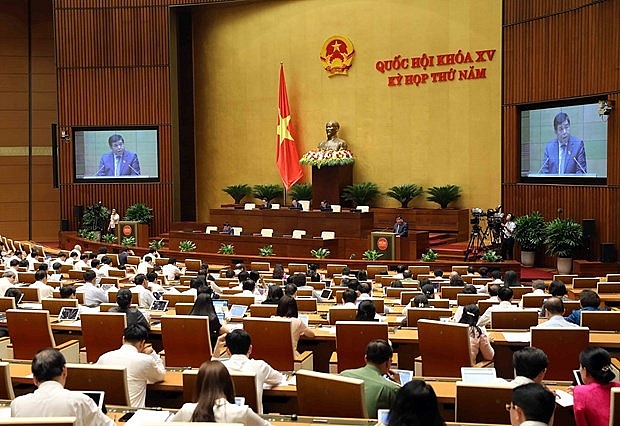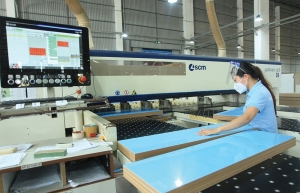Expectations for accelerated growth amidst tricky stretch
The National Assembly will from this week discuss the expectations of domestic economy performance until the year’s end. The upcoming discussions follow a lower-than-expected Q1 growth rate of 3.32 per cent on-year, which was the lowest Q1 growth for the past 12 years.
 |
| The 15th NA's fifth session is scheduled to take place in two phases, from May 22 to June 10 and from June 19 to 23. (Photo: VNA) |
The low economic growth is threatening the implementation of other goals for economic performance. The Ministry of Planning and Investment (MPI) has calculated that for the economy to achieve its targeted 6.5 per cent this year, it must grow 6.7 per cent in Q2, 7.5 per cent in Q3, and 7.9 per cent in Q4. The growth rates for the second half of the year must be at least 1 and 0.8 percentage higher than the Q3 and Q4 growth scenario of set in early this year (6.5 and 7.1 per cent, respectively).
“This is a very challenging scenario in the context that key impetuses for growth are weakening,” said MPI Minister Nguyen Chi Dung. “However, the government is now making every possible effort to boost domestic production and business activities.”
Prime Minister Pham Minh Chinh has required ministries and localities nationwide soon use sturdy solutions to help enterprises and people out of difficulties. “We have no plan to revise the growth goal for the year. Bigger efforts are to be made to boost production and business activities, and generate more employment,” PM Chinh stressed.
In April, many solutions have begun to produce positive results, the government reported to the National Assembly Standing Committee. April was also when service activities, especially tourism policies, began to be boosted. Thanks to this, there have been positive changes in a number of sectors such as corporate bonds, property, public investment, and money flows unclogged in the economy, the government said. Additionally, international organisations continued to release positive forecasts on Vietnam’s economic growth outlook for the year as a whole.
Elsewhere, in its macroeconomic updates about Vietnam released on May 10, Standard Chartered Bank lowered the country’s 2023 GDP growth forecast to 6.5 per cent from the previous 7.2 per cent. The bank also turned more cautious on the external front.
Standard Chartered forecasts that the State Bank of Vietnam (SBV) will make another 50 basis-point cut in the refinancing rate to 5 per cent by end-Q2, followed by rates on hold until end-2025. However, it sees upside risk to the rate forecast, especially towards year-end, as the SBV may focus more on financial stability than growth.
“The SBV has shifted to a pro-recovery stance since the start of 2023. In addition to cutting rates, it is aiding businesses facing difficulties by allowing them more time to address liquidity shortages. In April, it has allowed easier loan terms, including delaying loan repayments by up to 12 months and providing rate waivers. The property market may need further liquidity support, as measures so far appear to have only reduced short-term repayment pressure,” said Tim Leelahaphan, economist for Thailand and Vietnam at Standard Chartered Bank.
Fitch Solutions last week also said that Vietnam’s real GDP growth slowed sharply from 13.7 per cent on-year in Q3 of 2022 to 5.9 per cent in Q4 of 2022, and “we remain cautious” about the outlook for 2023.
“While the economy will receive support from a likely rebound in demand from mainland China, it will not be enough to offset the impact of a further weakening in global demand. With domestic inflation also set to rise a little further and monetary tightening underway, we expect GDP growth to slow from 8.02 per cent in 2022 to 6.5 per cent in 2023, below the pre-pandemic average of 7 per cent,” Fitch Solutions said.
Meanwhile, FocusEconomics noted that after decelerating in the fourth quarter last year, Vietnam’s economic growth lost speed again in Q1, driven by slowdowns in the agriculture and services sectors, and a contraction in the industry and construction sector. Weaker external demand and slower retail sales growth weighed on output.
“Turning to Q2, our panellists expect growth to accelerate and inflation to moderate. China’s continued recovery, coupled with lower interest rates, should boost growth ahead. Moreover, signs of recovery in the corporate bond market in March bode well for activity in Q2,” FocusEconomics told VIR. “That said, the SBV’s recent plan to limit the percentage ownership of banks that individual and institutional investors are permitted to hold will likely take its toll on investor sentiment, particularly for foreigners.”
According to the Asian Development Bank’s Asian Development Outlook released last month, Vietnam’s economic growth is expected to moderate at 6.5 per cent this year and further expand at 6.8 per cent in 2024.
 | Disbursement of assistance to be bolstered for enterprises The country’s hallmark socioeconomic recovery and development initiative must be accelerated as implementation continues to be too slow, the government has acknowledged. |
 | PSRD drive to headline agenda for coming months The colossal socioeconomic recovery and development initiative continues to suffer from numerous hurdles in implementation, irking the government which has ordered quicker deployment to achieve the desired economic growth. |
What the stars mean:
★ Poor ★ ★ Promising ★★★ Good ★★★★ Very good ★★★★★ Exceptional
Related Contents
Latest News
More News
- EVN launches major power infrastructure projects nationwide (December 19, 2025 | 18:17)
- VAL inaugurates second production line to meet domestic animal feed demand (December 19, 2025 | 16:37)
- Sun Group pioneers urban tram system in Phu Quoc (December 19, 2025 | 15:00)
- Seven major projects launched to drive Hanoi’s next growth phase (December 19, 2025 | 14:00)
- Securing capital and efficiency for Vietnam’s 2026-2030 growth ambitions (December 17, 2025 | 10:00)
- Vietnam bucking trend in the global M&A landscape (December 16, 2025 | 14:20)
- HDS Summit spotlights Vietnam’s rising role in regional supply chains (December 16, 2025 | 08:00)
- Kolon signs $48 million airbag supply deal with Autoliv (December 15, 2025 | 18:14)
- National Assembly approves Vinh–Thanh Thuy expressway project (December 15, 2025 | 18:02)
- Quang Tri green-lights $1.59 billion LNG-fired power project (December 15, 2025 | 17:59)

 Tag:
Tag:






















 Mobile Version
Mobile Version